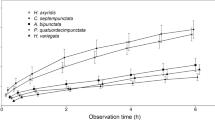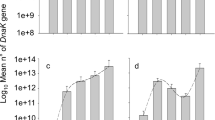Abstract
A field experiment involving aphid-free control and nutrient-stressed plants of 5 maize (Zea mays L.) genotypes was conducted to determine if predaceous aphidophaga use plant cues, such as colour, to select plants on which to forage. Nutrient stress resulted in plants lighter in colour (Yellow) than control plants in all the maize genotypes. Coccinellids were significantly more abundant on yellow plants than on greener control plants whereas chrysopids were significantly more numerous on controls in 3 out of 5 maize genotypes. These two groups of predators may use plant colour to partition habitat spatially and exploit their aphid prey while minimizing intraguild interactions.
Résumé
Une expérience de terrain avec des plants de maïs (Zea mays L.) de 5 génotypes différents et non infestés par des pucerons a été menée afin de déterminer si les prédateurs aphidiphages utilisaient un critère particulier pour choisir un plant. Plus précisément, l’intérêt était de savoir si les prédateurs étaient capables de discriminer entre des plants nutritionnellement stressés et des plants normalement fertilisés, étant donné que des carences nutritionnelles conduisent à des plants en apparence plus pâles (jaune). Des différences significatives ont effectivement été trouvées dans les choix qu’ont faits les prédateurs. Les coccinelles étaient plus abondantes sur les plants stressés que sur les plants non stressés alors que les chrysopes étaient plus nombreux sur les plants non stressés d’au moins 3 des 5 génotypes utilisés. Il est suggéré que les deux groupes de prédateurs se servent de la couleur des plants afin d’exploiter différentiellement dans l’espace les colonies de pucerons présentes dans un habitat donné. De cette façon, ces deux groupes de prédateurs minimisent les effets négatifs des interactions intraguildes.
Similar content being viewed by others
References
Banks, C. J. — 1957. The behaviour of individual coccinellid larvae on plants. —Brit. J. Anim. Behav., 5, 12–24.
Boethel, D. J. &Eikenbary, R. D. (eds) — 1986. Interactions of plant resistance and parasitoids and predators of insects. —Ellis Horwood Limited, Chichester, 224 p.
Braimah, H. &van Emden, H. F. — 1994. The role of the plant in host acceptance by the parasitoidAphidius rhopalosiphi (Hymenoptera: Braconidae). —Bull. Entomol. Res., 84, 303–306.
Carter, M. C., Sutherland, D. &Dixon, A. F. G. — 1984. Plant structure and the searching efficiency of coccinellid larvae. —Oecologia, 63, 394–397.
Coderre, D., Provencher, L. &Tourneur, J.-C. — 1987. Oviposition and niche partitioning in aphidophagous insects on maize. —Can. Entomol., 119, 195–203.
Coderre, D. — 1981. La bio-écologie de l’entomofaune prédatrice des populations aphidiennes du maïs-grain à St-Hyacinthe, Québec.M. Sc. thesis. Université du Québec à Montréal, 183 p.
Coderre, D. — 1983. Écologie des espèces aphidiennes et aphidiphages inféodées au maïs de la région sud du Québec.Ph. D. thesis. Université de Sherbrooke, 248 p.
Connell, J. H. — 1980. Diversity and the coevolution of competitors, or the ghost of competition past. —Oïkos, 35,131–138.
Dixon, A. F. G. — 1985. Aphid ecology.Blackie, Glasgow, 157 pp.
Ferran, A. &Dixon, A. F. G. — 1993. Foraging behaviour of ladybird larvae (Coleoptera: Coccinellidae). —Eur. J. Entomol., 90, 383–402.
Hemptinne, J.-L., Dixon, A. F. G. &Coffin, J. — 1992. Attack strategy of ladybird beetles (Coccinellidae): factors shaping their numerical response. —Oecologia, 90, 238–245.
Hemptinne, J.-L., Dixon, A. F. G., Doucet, J.-L. &Petersen, J.-E. — 1993. Optimal foraging by hoverflies (Diptera: Syrphidae) and ladybirds (Coleoptera: Coccinellidae): mechanisms. —Eur. Entomol., 90, 451–455.
Honek, A. — 1985. Habitat preferences of aphidophagous coccinellids (Coleoptera). —BioControl, 30, 253–264.
Lucas, E., Coderre, D. &Brodeur, J. — 1997. Instar-specific defense ofColeomegilla maculata lengi (Coccinellidae): influence on attack success of the intraguild predatorChrysoperla rufilabris (Chrysopidae). —BioControl 42 (1/2), 3–12.
Nordlund, D. A., Lewis, W. J., &Altieri, M. A. — 1988. Influences of plant produced allelochemicals on the host and prey selection behavior of entomophagous insects. In: Novel aspects of insect-plant interactions (P. Barbosa &D.K. Letourneau, eds). —Wiley, New York, 65–90.
Obrycki, J. J. — 1986. The influence of foliar pubescence on entomophagous species. In: Interactions of plant resistance and parasitoids and predators of insects (D. J. Boethel &R. D. Eikenbary, eds). —Ellis Horwood Limited, Chichester, 61–83.
Powell, W. &Zhi- li, Z. — 1983. The reactions of two cereal aphid parasitoids,Aphidius uzbekistanicus andA. ervi to host aphids and their food-plants. —Phys. Entomol., 8, 439–443.
Price, P. W., Bouton, C. E., Gross, P., McPheron, B. A., Thompson, J. N. &Weis, A. E. — 1980. Interactions among three trophic levels: influence of plants on interactions between insect herbivores and natural enemies. —Annu. Rev. Ecol. Syst., 11, 41–65.
Prokopy, R. J. &Owens, E. D. — 1983. Visual detection of plants by herbivorous insects. —Ann. Rev. Entomol., 28, 337–364.
Ricci, C. — 1986. Beneficial Coccinellidae caught in yellow traps in some italian regions. In: Ecology of Aphidophaga (I. Hodek, ed). —Academia, Praha, 311–447.
Ruzicka, Z. — 1994. Oviposition-deterring pheromone inChrysopa oculata (Neuroptera: Chrysopidea). —Eur. J. Entomol., 91, 361–370.
Ruzicka, Z. — 1996. Oviposition-deterring pheromone in Chrysopidae (Neuroptera): intraspecific and interspecific effects. —Eur. J. Entomol., 93, 161–166.
SAS — 1987. SAS Procedures, version 6.04,SAS Institute, Cary.
Vinson, S. B. — 1976. Host selection by insect parasitoids. —Ann. Rev. Entomol., 21, 109–133.
Whitman, D. W. &Eller, F. J. — 1992. Orientation ofMicroplitis croceipes (Hymenoptera: Braconidae) to green leaf volatiles: dose-response curves. —J. Chem. Ecol., 18, 1743–1753.
Author information
Authors and Affiliations
Rights and permissions
About this article
Cite this article
Lorenzetti, F., Arnason, J.T., Philogène, B.J.R. et al. Evidence for spatial niche partitioning in predaceous aphidophaga: Use of plant colour as a cue. BioControl 42, 49–56 (1997). https://doi.org/10.1007/BF02769879
Published:
Issue Date:
DOI: https://doi.org/10.1007/BF02769879




